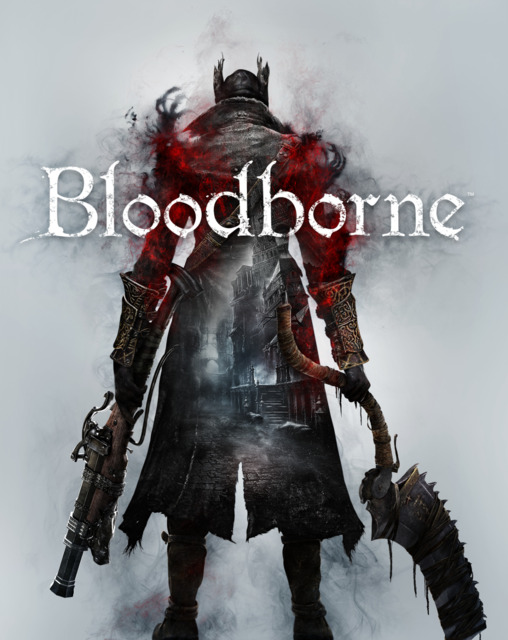The Straight and Narrow
“He who makes a beast of himself gets rid of the pain of being a man.”
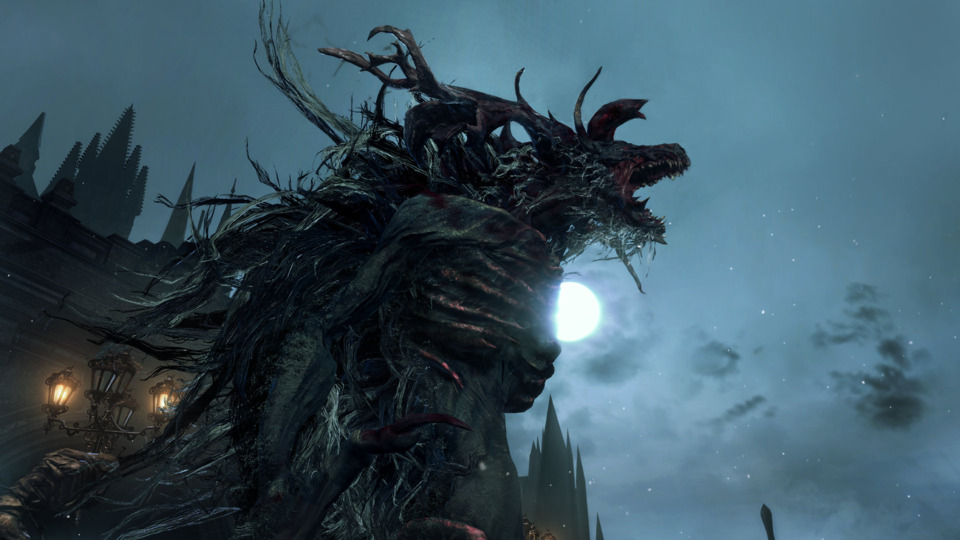
William Gibson once spoke of writing his first novel Neuromancer (which would become the progenitor of the cyberpunk genre) that by not explaining what certain slang meant or how certain machines operated, his key goal was for the reader to experience complete culture shock. In a similar fashion the Souls games provide the exact same feeling of entering a foreign world that isn’t conveniently waiting to explain itself, and yet through this strangeness it’s immediately apparent that it has existed for ages before we even got there - and it’s our job to become acquainted with it’s customs. Just like Gibson novels that feel completely baffling at first, you push on, figuring things out bit by bit, and by the end when you’ve completely become entrenched in the vernacular, looking back the journey feels all the richer for it.
While the first From Software release in a while to not feature their now trademark “Souls” in the title, Bloodborne is very much a Souls game in all but name. While there are some key differences in mechanics, the overall design remains true to the series. What really differentiates Bloodborne from past games is a Treyarch/Infinity Ward divide, where two teams work on the same product and for whatever reason one team actively decides not to use the solutions of the other. Since series creator Miyazaki did not directly work on the previous entry, some consider Bloodborne a true sequel, discounting Dark Souls 2 as a mere B-team stopgap. After having spent time with the game though, it becomes apparent that the B-team had some pretty good ideas that probably should have stuck around.
But what is Bloodborne about? Once again the player takes on the role of a newcomer, arriving to partake in a story that seems to have already ended before you even got there. Taking a step back from rustic castles, clunking armor and the medieval aesthetic as a whole, Bloodborne takes us to Yarnham, a fictional town reminiscent of a dark, victorian era London with the accents to boot. In short: You are a hunter and it just so happens to be the night of the hunt, when wild beasts prowl the streets and normal folk lock themselves in their homes awaiting the safety of dawn. The long version is that the onus is really put onto the player for how much you get out of the story part of the game. Series veterans know exactly what to expect when venturing forth, but newcomers might find that answers are in scarce supply and a helping hand is nowhere to be found. There are many indirect clues scattered throughout the world. Generally you are meant to piece the story together from sparse snippets of cryptic NPC dialog, studying descriptions of all the items you come across and correlating that information with enemy placement, their surroundings, their drops, everything. Everything. At first glance you might be killing a wacky enemy you just encountered along the way, but there might be a reason why that enemy is standing where they are, and why they drop the specific item they do. You have to pay real close attention to connect these loose strands back together and even then it’s all just speculation. Thats the kind of experience the Souls games offer, which isn’t for everyone of course, and Bloodborne is no different. I’ll say that if you really dive deep into the lore and use the internet to it’s fullest potential, there are some very interesting concepts at play, but it does require considerable effort to unearth.
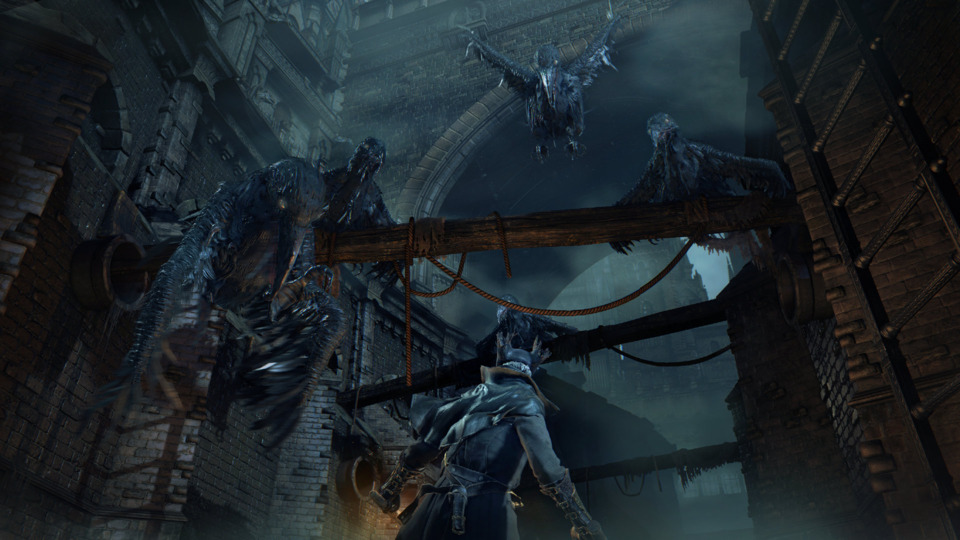
Gameplay fares much better in terms of clarity, but it’s not without it’s own set of mysteries. Generally the ebb and flow of combat has remained similar to past entries. Bloodborne is an action RPG that places heavy emphasis on player reflexes while augmenting them with stats. A big selling point of these games has always been the fact that there is never an enemy that you simply cannot face because you’re too low level. You might deal very low damage to said enemy, but if you are good enough at the game to evade all their attacks you will eventually whittle their health down to zero and prevail. Higher stats will merely expedite this process by giving you a bigger margin of error with higher health and more damage. The general idea is that stats don’t define what you can do in the game, but like any RPG being underleveled or overleveled can greatly influence how each enemy encounter is going to play out.
Despite the famous reputation for being both extremely difficult and overly obtuse, the Souls games are fairly straightforward in regards to the gameplay loop. You enter a new area, and methodically work your way through it until you find the boss at the very end. The world of Bloodborne can be generally divided into greater Yarnham and the Hunters Dream, which serves as your hub where you’ll be able to level up, upgrade weapons, buy items and engage in optional side dungeons. It’s a neutral area, completely disconnected from the rest of the game world that contains no enemies and is the only place from which you can travel to other parts of the world. Lamps are strewn throughout the many different areas of Yarnham acting as both spawnpoints should you die, and a means of traveling back to the Hunters Dream. When entering a new area your first goal will usually be to locate the next lamp in sequence. Level design is probably the best we’ve seen in the series. Not only is this the most detailed world that From Software has crafted yet, but the paths within each major zone twist and turn in such unexpected ways that finding and unlocking shortcuts not only brings a sigh of relief but also a sense of awe. You might crawl up onto rooftops, descend down into sewers, only to come back out and ride an elevator that opens up right beside the lamp that you started from in the first place - it can sometimes take a moment to find your bearings and marvel at how ingeniously From Software has connected these paths through the sprawling city. Exploration is key as all major pieces of loot are statically placed throughout the world as opposed to being random drops from enemies. Ultimately your goal in each area is to defeat the boss, thereby unlocking the next place to explore and furthering the storyline..
Stats are still increased by way of defeating foes and absorbing their blood, which you then cash in at home base in the ethereal Hunters Dream. Blood or “blood echoes”serve as the ultimate currency which can be used to purchase stat points, equipment, weapons or items. It’s also a currency that you always carry on your person, and if you were to perish in combat it will remain on the ground where you died in the form of a bloodstain that you’ll need to run back to collect. Die on your way there it and your hard earned blood echoes are gone forever. This system is one of the main reasons Bloodborne can be so exhilarating despite it’s rather slow and methodical approach to combat. The pressure ramps up slowly but surely as you require more and more echoes to level up, making death and the potential loss of currency a growing concern. You may find yourself deep into a peculiar area, having amassed enough echoes to level up two or three times, but you don’t know what is coming up ahead. Do you risk it all and keep going, hoping to find a lamp that will teleport you to the safety of the Hunters Dream, or do you backtrack the way you came and cash in all your echoes before venturing forth once more, now bolder and wiser from your initial excursion.
Returning are player messages and death phantoms that mark the unique online feature of these games. Using a set of templates, players are able to leave messages on the floor warning others of ambushes, directing them towards hidden secrets, or tricking them into jumping down bottomless pits to their doom. Seems like a small thing, but sometimes a message could literally save your life. The death phantoms that show the last few seconds of a players life before they perished are equally helpful but in my experience with the game they rarely worked. Co-op works much like it did in previous games except it now uses the new Insight currency. At nearly any part of the game a player can ring a small bell in order to summon nearby players into their own game to help out. Similarly players that are looking to help out need only ring their own bell, and wait to get sucked into a work that is beckoning for help. There are minute differences, such as helper phantoms being sent back to their lamps if they die in the hosts world instead of appearing back where they were summoned from, but generally the mechanic is very similar. The severe lag you experience while playing co-op is very much a brand new, and very unwelcome, addition.
A big addition to the series are the Chalice Dungeons which are accessible at any time from the Hunters Dream, granted you have the right materials. These are optional side dungeons that start out the same for all players, but can be randomized and played on higher difficulties when using special items. Although it’s a little jarring at first to see such mechanical level design, crafted from prefab pieces, there are plenty of unique enemies and some items that not only extend the life of the game but offer a level of challenge not found in the main game.
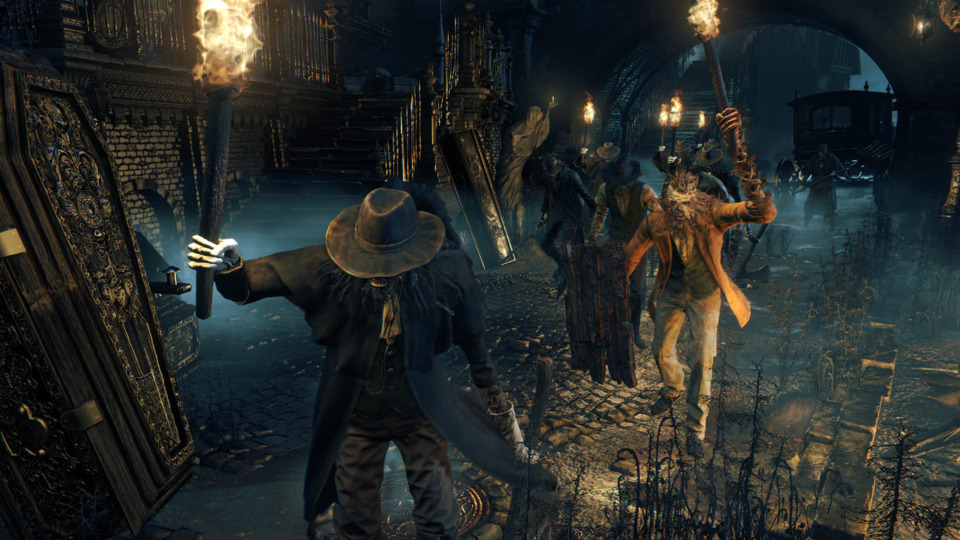
Combat is probably the biggest change some veterans of the series will have to adjust to. In order to craft a faster and more mobile experience Bloodborne puts a heavy emphasis on aggressively engaging your foes. There are no practical shields or heavy armor in the entire game that might help to mitigate incoming damage. Instead you are meant to be constantly moving about and dodging instead of passively taking hits with a shield. In the spirit of this active combat approach your offhand can be equipped with a firearm that is used to interrupt enemy attacks and put them into a stunned state from which you can pull off a “visceral attack” that deals critical damage. Likewise healing has also been refined to allow mobility. Gone are estus flasks that would glue you to the ground while you healed, instead being replaced by blood vials that are replenishable through enemy drops and allow you to move while you pop them off. Health also uses a regain system that allows the player a short window of opportunity to get it back by dealing damage. Upon getting hit the lifebar moves back into a lighter shade, indicating a portion that can be regained if you attack an enemy quick enough. All of this makes for a quicker, lighter game, that favors hit and run techniques and punishes passivity.
Apart from those changes it’s business as usual. Besting typical mobs you find along the way requires little more than memorizing their limited moveset and dodging accordingly while managing your stamina between attacks. When locked-on the regular roll turns into a quick dash that seems to have even more invincibility frames than your regular roll, and evading as a whole takes very little stamina which in turn replenishes very rapidly. All weapons have some manner of transformation that clicks into place with satisfying shower of sparks and a loud clank. Unfortunately despite their cool look, most of the weapons in Bloodborne are basically the same weapons we’ve been using for the past three games. The movesets seem fairly identical, with your standard short sword, falchion, rapier moveset. You might be hold a giant looking cleaver, but it moves the same way your falchion did three games prior. In that Bloodborne is slightly underwhelming, as there are way less weapons overall, and what there is acts just like the weapons you’ve used for hundreds of hours prior. Transformations are neat, but they’re a glorified two handed mode that is now repurposed with a cool new animation. There is some usefulness to this mechanic as it allows for limited variety, like a greatsword that can transform into a single handed straight sword, but generally apart from looking really cool it’s nothing we haven’t seen these weapons do before.
Soul games have always been about choice. The player had dozens of options on how to approach both the world and character growth from the very beginning of their adventure. Strangely enough Bloodborne takes a step back from what Dark Souls 2 had built and instead is a much more focused and simultaneously limiting experience. There is no more equipment load so you’re no longer managing your weight because roll speed is always the same. All armor that can be found is within 10-20 stat points of each other making them more of an aesthetic choice rather than a meaningful build option. Weapons are generally strength or skill (dexterity) based, with the game heavily favoring the strength variety. There is some magic but it mostly comes in the form of buffs and surfaces beyond the halfway point, meaning you’d be dumping points into a build that won’t be useful for the first 15-20 hours of the game. There is also a blood stat which governs firearms and buffs certain primary weapons that are also almost all exclusively found in a high level optional area unlocked towards the second half. This leaves the player with two build choices honestly: strength or skill. There are more strength based weapons in the game, and the way they’re able to stunlock both enemies and bosses more than makes up for their lack of speed. Skill weapons overall, such as the threaded cane or the blades of mercy, have very little going for them apart from speed. The trade-off is that while you do less damage with each hit you can attack more often, but up against bosses and bigger foes this doesn’t work so well in practice as you have to dodge back to avoid attacks interrupting what would normally be your longer attack string. Ironically while the strength weapons hit slower, they will often stun your opponent allowing for more continuous hits than their skill based counterparts.
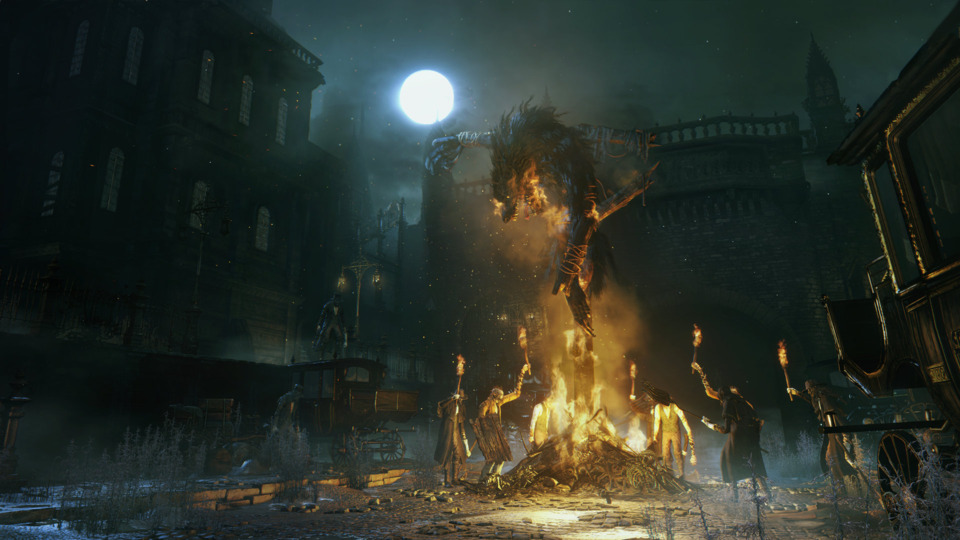
By forcing the player to fight more actively From Software has effectively funneled everyone into a very specific playstyle. In any of the previous Souls games you had an option to bulk up with heavy armor and get the biggest shield you could, or put on lightweight clothes and dual wield a greatsword, or carry a small shield in your off hand and use it for riposting much like the guns are used in Bloodborne, or carry two swords and riposte with your offhand sword, or use magic which was readily available from the outset of the game, so on and so forth. The possibilities seemed endless and it catered to many different playstyles. Bloodborne can only really be played the one way. You mostly dodge and if you want to get fancy you can parry with the gun once in a while but honestly you could go the whole game ignoring the parry mechanic and be just fine. This severely limits replayability in a series that was known for just that. I finished the entire game using the same weapon I chose at the very start, wearing the same gear I found in the very first area of the game. This is disappointing when compared to the dozens of armor sets and weapons I was mix and matching throughout Dark Souls 2 even before I got the the halfway point.
Bloodborne is also the most technically flawed game of the bunch. It is truly astounding that From Software is on their fourth game in the series and we are still experiencing the exact same bugs we’ve been seeing since Demon’s Souls. NPC quests while already extremely esoteric in nature will break at random, as they have been prone to do in the past. Dark Souls 2 introduced an improved lock-on system that allowed you to target boss limbs, something that Bloodborne didn’t see fit to incorporate, resulting in the worst camera and lock-on the series has ever seen. The very first boss fight against the Cleric Beast is nearly unplayable if the player chooses to lock-on, causing the camera to constantly clip outside of the boss arena blocking off your view, only to snap back in way too close because of the tight surroundings. Visceral attacks (backstabs from the front) are still extremely finicky to pull off. You’re too close, it won’t work, too much to the side, too far, higher or lower than the enemy, it just won’t work. Hit boxes can still be an issue especially in boss fights. This isn’t even mentioning the now famously long load times and inconsistent framerate. Bosses while extremely creative in their design will more often than not be an exercise in frustration as the camera simply cannot handle following creatures so much bigger than you, forcing you to fight without lock-on, which in turn restricts you from using the evasive dashes which are the one good improvement to the combat.
Bloodborne also suffers from the typical Souls problem of losing direction in the latter half of the game. In an effort to introduce a narrative twist, halfway through it becomes less clear what it is you’re doing, where you should go or what your overall goal is. You fall back on basic instinct of travelling through an area and killing a boss at the end, but it all seems rather disconnected from the first 15 hours of the game. Obviously there are storyline reasons for why this part of Bloodborne plays out the way it does, but it takes a lot of sleuthing through the little lore you have access to in order to start making educated guess for what it is.
All these problems aside Bloodborne is still a great game and a unique experience, especially for new players. In a market saturated with constant tool tips and waypoints, the Souls games are always a refreshing reminder of what it was like to get truly lost in a videogame. It’s simply disappointing that what should have been a brand new start for the franchise in a new generation, turned out to be merely a fresh coat of paint with all the old baggage in tow. It’s beginning to be hard to tell whether From Software simply lacks the technical talent to overcome these hurdles, or whether they simply don’t care. While obviously not for everyone, Bloodborne is one of the best games out on the PS4 right now, a must-have for returning Souls veterans and a good starting point for curious newcomers alike.
